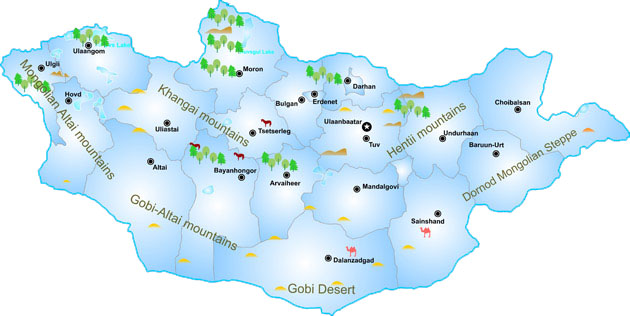Geography

Mongolia is one of the few countries in the temperate belt of the Northern Hemisphere with vast territory, perfect ecosystem and virgin land. Its remarkable variety of natural contrasts consist of upland steppes, semi-deserts, and deserts, although in the west and north forested, high mountain ranges alternate with dry, lake-dotted basins. The geography of the country is characterized by a great diversity. It is divided into four regions: mountainous, forest steppe, steppe and desert step. Though people don’t think of Mongolia as a mountainous country, much of the country’s territory is mountainous. About 80% of the entire territory is hundred meters above sea level. There are three major mountain ranges: the Mongol Altai, Hangai and Hentii. The Mongol Altai in Western Mongolia is the highest and remotest mountains in the country. The Altai Mountains have many summits reaching 4000 meters above sea level. Over 20 peaks are capped with eternal snow in the Altai Mountain Range. These include Tavan Bogd’s Huyten Peak (4,374 meters), the highest point in Mongolia. A smaller range splitting off to the southeast is the Gobi Altai sub mountain range. Its southeastern extremities also split into a number of smaller hills, disappearing in the expanses of Gobi.
The Hangai Mountains are the largest of the three major mountain ranges. It extends 800 kilometers from the west to the east. Its highest peak is Otgon Tenger (4021 meters). The Hangai Mountains landscape is different from the Altai Mountains. While high rocky cliffs and deep basins are dominant in both Mongol Altai and Gobi Altai, the Hangai Mountain Range is featured by broad, warped dome shaped mountains covered with grass and trees. The area encompasses several natural zones including mountain and mountain steppe zone, Siberian taiga and forest. Fertile soil and numerous rivers, streams and lakes support a variety of plants and the area is habitat to a huge array of animal species. The third mountain block is the Hentii Mountain Range. It is smaller and lower than the Altai and Hangai Mountain Ranges. The Hentii Mountain Ranges starts from just east of Ulaanbaatar and stretches to the great eastern plains. There are several peaks that rise above 2,500 meters above sea level, with the highest one being Asralt Khairkhan which keeps ancient mountain glacial traces. The Hentii Mountains are covered by forests, wetland, alpine tundra, and permanent snow and ice fields: the core of this remote wildness area is totally uninhabited.










